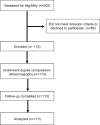VTE Incidence and Risk Factors in Patients With Severe Sepsis and Septic Shock
- PMID: 26111103
- PMCID: PMC4631038
- DOI: 10.1378/chest.15-0287
VTE Incidence and Risk Factors in Patients With Severe Sepsis and Septic Shock
Abstract
Background: Prospective studies on the incidence of VTE during severe sepsis and septic shock remain absent, hindering efficacy assessments regarding VTE prevention strategies in sepsis.
Methods: We prospectively studied 113 consecutively enrolled patients in the ICU with severe sepsis and septic shock at three hospitals. All patients provided informed consent. VTE thromboprophylaxis was recorded for all patients. Patients underwent ultrasonography and were followed for VTE prior to ICU discharge. All-cause 28-day mortality was recorded. Variables from univariate analyses that were associated with VTE (including central venous catheter [CVC] insertion, age, length of stay, and mechanical ventilation) were included in a multivariable logistic regression analysis using backward stepwise elimination to determine VTE predictors.
Results: Mean APACHE (Acute Physiology and Chronic Health Evaluation) II score was 18.2 ± 7.0, and age was 50 ± 18 years. Despite all patients receiving guideline-recommended thromboprophylaxis, the incidence of VTE was 37.2% (95% CI, 28.3-46.8). Most VTE events were clinically significant (defined as pulmonary embolism, proximal DVT, and/or symptomatic distal DVT) and associated with an increased length of stay (18.2 ± 9.9 days vs 13.4 ± 11.5 days, P < .05). Mortality was higher in patients with acute VTE but did not reach statistical significance. Insertion of a CVC and longer mechanical ventilation duration were significant VTE risk factors. VTE incidence did not differ by thromboprophylaxis type.
Conclusions: To our knowledge this is the first multicenter prospective study to identify a high incidence of VTE in patients with severe sepsis and septic shock, despite the use of universal, guideline-recommended thromboprophylaxis. Our findings suggest that the systemic inflammatory milieu of sepsis may uniquely predispose patients with sepsis to VTE. More effective VTE prevention strategies are necessary in patients with sepsis.
Trial registry: ClinicalTrials.gov; No.: NCT02353910; URL: www.clinicaltrials.gov.
Figures


Comment in
-
Increased Incidence of VTE in Septic Shock: Is this Preventable?Chest. 2016 Apr;149(4):1107. doi: 10.1016/j.chest.2015.12.040. Chest. 2016. PMID: 27055704 No abstract available.
-
Response.Chest. 2016 Apr;149(4):1107-8. Chest. 2016. PMID: 27512739 No abstract available.
References
-
- Attia J, Ray JG, Cook DJ, Douketis J, Ginsberg JS, Geerts WH. Deep vein thrombosis and its prevention in critically ill adults. Arch Intern Med. 2001;161(10):1268-1279. - PubMed
-
- Cook D, Attia J, Weaver B, McDonald E, Meade M, Crowther M. Venous thromboembolic disease: an observational study in medical-surgical intensive care unit patients. J Crit Care. 2000;15(4):127-132. - PubMed
-
- Ribic C, Lim W, Cook D, Crowther M. Low-molecular-weight heparin thromboprophylaxis in medical-surgical critically ill patients: a systematic review. J Crit Care. 2009;24(2):197-205. - PubMed
-
- Marik PE, Andrews L, Maini B. The incidence of deep venous thrombosis in ICU patients. Chest. 1997;111(3):661-664. - PubMed
-
- Hirsch DR, Ingenito EP, Goldhaber SZ. Prevalence of deep venous thrombosis among patients in medical intensive care. JAMA. 1995;274(4):335-337. - PubMed
Publication types
MeSH terms
Associated data
Grants and funding
- AG048022/AG/NIA NIH HHS/United States
- AG040631/AG/NIA NIH HHS/United States
- UL1 RR025764/RR/NCRR NIH HHS/United States
- R03 AG040631/AG/NIA NIH HHS/United States
- UL1RR025764/RR/NCRR NIH HHS/United States
- U54 HL112311/HL/NHLBI NIH HHS/United States
- 8UL1TR000105/TR/NCATS NIH HHS/United States
- K23 HL092161/HL/NHLBI NIH HHS/United States
- R01 AG048022/AG/NIA NIH HHS/United States
- R01 HL126547/HL/NHLBI NIH HHS/United States
- UL1 TR000105/TR/NCATS NIH HHS/United States
- HL112311/HL/NHLBI NIH HHS/United States
- HL092161/HL/NHLBI NIH HHS/United States
- UL1 TR001067/TR/NCATS NIH HHS/United States
LinkOut - more resources
Full Text Sources
Other Literature Sources
Medical

